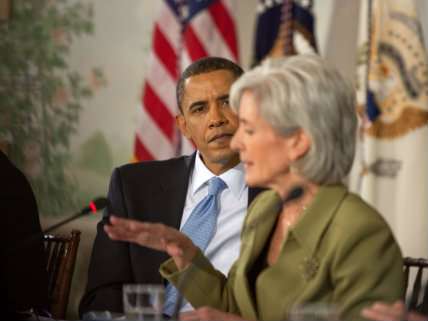Obamacare's Enrollment Target Slips Away, and Other Takeaways From Today's Enrollment Report

In September 2013, the month before Obamacare's health insurance exchanges launched, Health and Human Services Secretary Kathleen Sebelius was asked by NBC News what success would look like for Obamacare. "Success," she responded, "would look like at least 7 million people signing up for coverage by the end of March," the final month of open enrollment for the health law's first year.
But based on the administration's report this afternoon that just 4.2 million people had signed up for coverage by the end of February, that goal now looks all but impossible to reach.
With open enrollment ending in just a few weeks, there's not much time left to make up the gap. Indeed, even if there's a significant sign-up spike in the final month, the administration is still likely to significantly undershoot its target.
We'll find out soon enough. In the meantime, here are the key takeaways from today's enrollment report.
The administration is still well behind its initial enrollment target—which now seems out of reach. Even with relatively steady sign-ups in January, and a so-so total February, the pace hasn't picked up enough after the slow opening. The administration is counting on a spike in March to make up lost ground, but it's going to have to be really big to even come close. About 1.78 million people signed up for coverage in December, the month with the highest number of sign-ups so far. The administration needs a 63 percent increase from that month's turnout to get the 2.8 million sign-ups necessary to reach 7 million by the end of March. Even hitting the Congressional Budget Office's revised estimate of 6 million sign-ups by the end of March seems like something of a stretch at this point.
The administration is still counting sign-ups, not completed enrollments—so the real number of paid enrollments is substantially lower. The monthly "enrollment" reports released by the administration don't actually count enrollments. Instead, they count people who have "picked a plan" within the exchange system. But multiple reports from insurers suggest that about 20 percent of people who sign up aren't paying their first month's premium, and thus aren't enrolled. Other reports suggest a further attrition through non-payment of around 2 to 5 percent in the second month. What this means is that whatever the final number of sign ups is, the true number of enrollments will be significantly smaller.
The percentage of young adults signing up isn't increasing. When it started to become likely that the administration wouldn't meet its enrollment goals for the year, the White House changed the definition of success, arguing instead that what was really important was getting a healthy demographic mix of enrollees, with around 39 percent of enrollments coming from young adults aged 18-34. In December, the administration, along with other supporters of the law, pointed hopefully toward the increasing number of young adults as a sign that the demographic mix might work out. But the percentage of young adults who've picked plans has barely budged since then. At the end of December, 24 percent of sign-ups were between 18 and 34; now, at the end of February, it's still holding at 25 percent.
California still leads the way. Of the 4.2 million people who've selected a coverage option, 868,936 are from sunny California. No other state even comes close; the next highest sign-up totals come from Florida (442,087), Texas (295,025) and New York (244,618).
There are large disparities between the states. In contrast to states like California, states with broken exchanges, like Hawaii and Massachusetts, still have tiny sign-up totals. Massachusetts has signed up just 5,943 people for coverage. Hawaii has signed up 10,968.
The vast majority of people signing up for coverage are eligible for subsidies. The administration reports that 83 percent of those who've picked plans qualify for the health law's tax credits to purchase insurance—a figure that has risen slightly over the last few months.
More women are signing up than men. Of the 4.2 million people who have picked plans so far, 55 percent are women and 45 percent are men. That makes sense since the law prohibits differential pricing based on gender. But it also suggests that the risk pools in the exchanges will be weighted toward people who are generally more expensive to insure.
This doesn't tell us how many uninsured people have gained coverage under the law. Even if we knew how many of the sign ups were paid enrollments, that would not tell us how many previously uninsured people were gaining coverage thanks to the law. Survey data suggests that the number is much smaller than the overall sign-up totals, perhaps just a quarter of all people signing up for coverage. But the bottom line is that we just don't know, because the administration is not systematically tracking that data.


Show Comments (35)